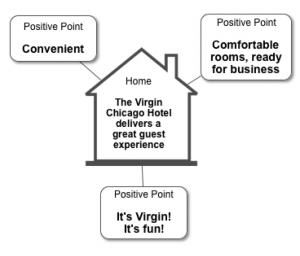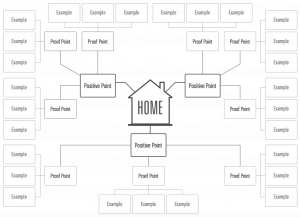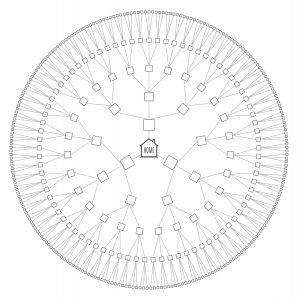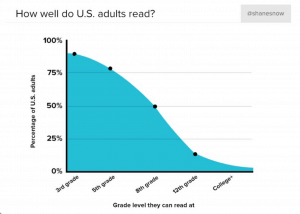
To cut through, tell a simple human story
How Message Maps help you tell your story better
Follow 3 basic principles to make your story more simple, human and scalable.
Make your story simple
Your audience is bombarded by 1,500 to 30,000 messages per day. That’s why making a simple human story helps you break through all that clutter.
A Message Map makes your story simple because your whole story fits on one page. With one page, you can easily deliver a consistent story in live, digital or print media.
Focus on delivering one main message, your home base. When you have one main message, there’s a better chance your story will stick in the minds of the audience.
Give the audience enough reasons to believe your main message, but not too many. You need 3 or 4 positive points to back up your home base.

Multiple messages overwhelm audiences and are easily forgotten. Remember: audiences can act only on what they recall.
Make your story human
The home base of a Message Map always answers your audience’s question: what’s in it for me? (WIIFM?)
Answering WIIFM humanizes your story. To answer WIIFM well takes the:
- Empathy to know what audiences want
- Experience to know how much you can promise
- Credibility to be believed.
Message Maps employ plain words, short phrases, and global English. They avoid specialists’ language, using layman’s language instead.

Message Maps help prevent the curse of knowledge, which happens when specialists can’t tell a story to laymen, because they assume too much knowledge on an audience’s part.
By sticking with plain words, your Message Maps garner a bigger audience.
Make your story scalable
Nowadays, stories must fit into the time and space that audiences allot. This same principle applies whether you create a 140-character Tweet or a 140-page E-book.
With a Message Map, you can scale your story to fit as needed. Make your story as short as 7 seconds or 23 words to fit into people’s short attention spans.
Seven seconds is the perfect size for a sound bite in a news story, a headline and subheads, or a Tweet.
Once you’ve won an audience’s interest with a 7-second message, a Message Map makes it easy to scale up to 2 minutes, 5 minutes, 20 minutes or more – with complete consistency.

The structure of a Message Map is fractal. Fractals build by repeating the same form over and over, branching it out.
A Message Map starts in the center with one main message or home base. Home base is supported by 3 or 4 positive points. Each positive point is supported by 3 or 4 proof points. Each proof point can be supported by 3 or 4 exampless. It’s easy to see the fractal pattern in a 5-level Message Map.
Each point in a Message Map links to a higher level of the message, all the way back to home base. Each point also may be supported by lower-level points.
Points radiate from home base to the outer layer. In a Message Map, points always connect radially all the way back to home base (rather than connecting between unrelated branches).
As your story progresses from center to the outside of the map, it grows more granular.
Examples include facts, quotes, quips and anecdotes that support the story. They form the outer layer of a Message Map. Quantitative data usually gravitates toward the outer layer.
Message Maps work in both directions – inside-out as a storytelling tool and outside-in as a Q&A tool.
- Inside-out: When you tell your story, begin at home base and work your way to the outside of the map.
- Outside-in: As you answer questions, begin with the relevant data point on the outside layer, then work your way through the connecting points back to your home base.
Either way, you’re prompted to repeat your home base enough times for it to sink in with the audience.

Why’s it so important to keep your words plain and simple? Studies show that 100% of Americans can understand a 7-word sentence. But as sentences grow longer, fewer and fewer people comprehend them.
Make Message Maps simple and you can expand your addressable audience.
The best Message Maps are inclusive. The best stories address all your stakeholders – customers, investors, employees and influencers – with one unified, consistent message. Don’t create separate messages for each audience, since that may add fuel to stakeholder conflicts.
A good Message Map makes your story more simple, human and scalable. So, you can win your audiences’ attention and address their needs. That makes a story they’ll remember.
Related Posts
Infographic: Fast-Forward Your Content Marketing
Take 7 steps to get content on track. Fast-Forward Content Marketing To fast-forward content marketing, use a practical 7-step approach. These 7 steps can help you launch or...
How Do Content Marketers Measure Meaningful Web Traffic? And Get the Credit?
At Content Marketing World, I invited content marketers to ask questions about How to Speed the Journey from Content to Cash. One great question...
Discover a tool that makes 24 communications jobs easier to do
Discover a tool that makes 24 communication jobs easier to do Does your company have one crystal-clear, consistent, and compelling strategic message? Every company...
Why Marketing Messages Seem Like Potluck: Too Many Chefs
Businesses struggle to control their own messages, their own story. One reason is that big businesses often have too many chefs in the kitchen, each...





